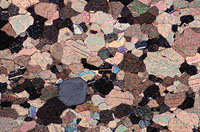
"There's no bismuth like show bismuth" *
Useful resources from the Web
Life beyond Wikipedia ...MELTS. Thermodynamic calculation system for predicting phase equilibria in basaltic magmas. Largely the work of Mark Ghiorso, who established and taught this class back in the days when it was Geology 391, and co-taught it again in 2012. The site also provides fun web-based calculators you can use to obtain thermodynamic properties of individual minerals and predict solid-state reaction boundaries. It's amazing how often questions about geochemically interesting solid-state reactions turn up on exams for this class (see the FAQ page).
PHREEQ. For aqueous geochemical calculations it is difficult to solve by hand all of the participating equilibria, incorporate activity coefficients, and so on. Instead, there are calculation packages like PHREEQ available on the web (or you can download a stand-alone version of the program for the PC.
For many years Geochemistry, by William M. White was available on the web, chapter by chapter, as a set of pdf files. It is now published, and you can place a pre-order through this link. This is probably the best and most comprehensive book ever written about Geochemistry, and making it available as a teaching resource to students (and professors) via the web for many years was a generous act given the labor required to produce it. So: (i) Here is a quiet acknowledgement to Bill White for such altruism in the name of science (which is what the Web used to be all about). (ii) Reward the author and buy a copy [Disclaimer: Not a sponsored link]. ESS 312 students should note that this book is more advanced and covers the subject in much greater depth than we can in class. As a text it's aimed more towards the graduate level, but if you're serious about the subject and intend to go on with it in future, you'll find a lot that's familiar treated in great detail. Highly recommended.
This is the best compilation of ionic radii that I have found on the web. It gives a comprehensive listing of radii for different charge states and co-ordination numbers.


